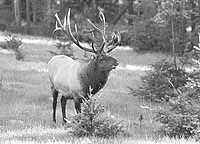| Hunters are urged to use caution while transporting deer and elk parts into Utah. There has been evidence suggesting that chronic wasting disease does exist in wildlife in several surrounding states. To avoid the spread of the disease, hunters are asked to follow the above listed guidelines while transporting wild game. |
Hunters who take elk, mule deer or white-tailed deer in areas outside of Utah where chronic wasting disease has been found may not bring certain parts of those animals into the state. An emergency rule not allowing importation of certain animal parts was approved Sept. 10 by the Utah Wildlife Board.
Importation of harvested elk, mule deer or white-tailed deer, or certain parts of those animals, will not be allowed if the animals were taken in any of the following areas:
•Colorado game management units seven-nine, 12, 19-20, 29, 87-96, 191, and 951.
•Nebraska counties of Cheyenne, Kimball, Sioux, Scotts Bluff.
•New Mexico, White Sands Missile Base.
•Saskatchewan wildlife management zone 46.
•South Dakota, Fall River County.
•Wisconsin deer management zones 54, 70-71, 73, and 75-77.
•Wyoming deer hunt areas 10, 14-16, 22, 55, 57, 59-67, 73, 88, 105 or elk hunt areas 5-7.
Hunters who do take animals in these areas will be allowed to bring the following animal parts into Utah:
•Meat that is cut and wrapped either commercially or privately.
•Quarters or other portions of meat with no part of the spinal cord or head attached.
•Meat that is boned out.
•Hides with no heads attached.
•Skull plates with antlers attached that have been cleaned of all meat and tissue.
•Antlers with no meat or tissue attached.
•Upper canine teeth, also known as buglers, whistlers, or ivories.
•Finished taxidermy heads.
“There’s no evidence that deer and elk in Utah have chronic wasting disease and we want to do everything possible to keep it that way,” explained Lou Cornicelli, wildlife manager with the Utah Division of Wildlife Resources.
“The disease centers itself in certain parts of deer and elk and those are the parts of animals that we don’t want brought into the state.”
Chronic wasting disease (CWD) was recently found in wild deer near Craig, Colo. about 70 miles east of the Utah border. The DWR will conduct extensive CWD testing this fall on Utah hunting units that border Colorado.
“Only deer will be tested because they’re the most susceptible to CWD,” Cornicelli stated. “The last extensive testing in Utah was done in 1998 and 1999, when a total of 700 deer and elk were tested. All of those animals tested negative for CWD.”
Utah limited entry and antlerless deer hunters will also be asked to help. They’ll receive a letter soon, requesting assistance with CWD sampling of animals they take this fall.
The DWR will also release a brochure in the next few weeks that provides the public with information about CWD and efforts the agency is making to minimize the chance of the disease entering Utah.

